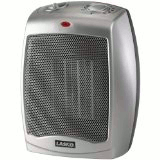portable ceramic electric heaters & Lasko, holmes, delonghi and honeywell
Ceramic heaters are becoming the most popular type of small space heaters; they generate heat by passing electricity through heating wires embedded in ceramic plates.
Common ceramic heaters are small-compact units for personal heating, that is, designed to directly heat the people and the immediate space surrounding them; they aren't intended to heat an entire room.
Their designs vary greatly (tower models, models with oscillation, compact units...), as well as their capacity (typically below 1,500 watts).
Ceramic vs. other Infrared Heaters
Ceramic Electric Heaters are intended to heat people in their line of sight, not entire rooms.
They provide personal spot heating.
Most units are small and cheap.
They heat up quickly.
They have several settings.
Some fan units can be noisy.
Prefer a UL listed unit.
 Like quartz heaters and the outdated metal-sheath space heaters, ceramic heaters are electric-resistance devices able to emit special infrared waves (long wavelength).
Like quartz heaters and the outdated metal-sheath space heaters, ceramic heaters are electric-resistance devices able to emit special infrared waves (long wavelength).
These several types of small heaters differ in their heating medium: a ceramic core, a quartz tube or lamp, or a metallic coil.
Ceramic heaters are, typically, the most effective type of electric-resistance radiant heaters. They have several advantages over quartz and metal-sheath space heaters.
Tower, fan and compact Ceramic heaters
Remote controls, oscillation, timers and programmable thermostats and carry handle features are features that you can also look for in this type of heaters.
Some ceramic heaters are fanless, but most models have fans. Fans make the heaters noisier but provide a few advantages (see: Fan and fanless small electric heaters).
Manufacturers and Brands: Lasko, Holmes, Delonghi, Honeywell
Lasko has dozens of popular and inexpensive ceramic heaters (tower, oscillating, personal and others).
Holmes, Delonghi and Honeywell have also a wide offer.
Brands with the best reviews and prices
Online prices range between $20 and $90. For prices and customer reviews at Amazon.com, see: Ceramic space heaters.
Heating elements, Fans and other features of Ceramic Infrared Heaters
Features vary with the models, the manufacturers and the prices: adjustable louvers; heat settings; fan-only function; built-in thermostat; timer; filter; air purification; automatic shut-off; power indicator light; recessed handle; oscillation; remote control; automatic temperature control; touch screen; LCD screen; wall mountable.
Even the cheapest ceramic heaters have an adjustable thermostat with three or more settings; for instance: a 1500-watt high setting (around 5,000 BTU's), a 900-watt low setting (say, around 3,000 BTU's) and a fan-only option (no-heat air circulation, for summer cooling). Most heaters include automatic overheat protection. 
Cleaning and maintenance is easy to perform. The grill can be cleaned with a vacuum cleaner; pay attention to periodic removing of lint and dirt from the inside of the heater.
Warranties
Prefer a UL-listed ceramic heater, or other qualified model. Look for a unit with a three-year warranty; most units have a one-year warranty.
Electric ceramic heaters are safe devices; prefer a unit with a safety switch, to turn the heater off should it fall over.
Prices
More expensive units, with advanced features, may cost you around $70-$90. Small and popular models are sold online at prices around $20-$40.
Residential uses, garages, advantages and Disadvantages
These heaters are typically portable and personal units that can be used wherever we want them.
Ceramic heaters heat up quickly and provide good levels of comfort, but they are not designed to heat entire rooms, be them residential rooms, or garages or any other.
They are designed to emit radiated heat in a specific direction. They may use reflectors to focus the heat, or not; some simply allow the heat to dissipate in the direction they are facing.
Over time, they will increase the room’s air temperature, but that’s not their main goal. They are intended to heat people in their line of sight, not entire spaces. Do not expect them to be able to heat large rooms; they aren't designed to provide it.
![]() Related Content
Related Content
![]() Top .... Home Page
Top .... Home Page


